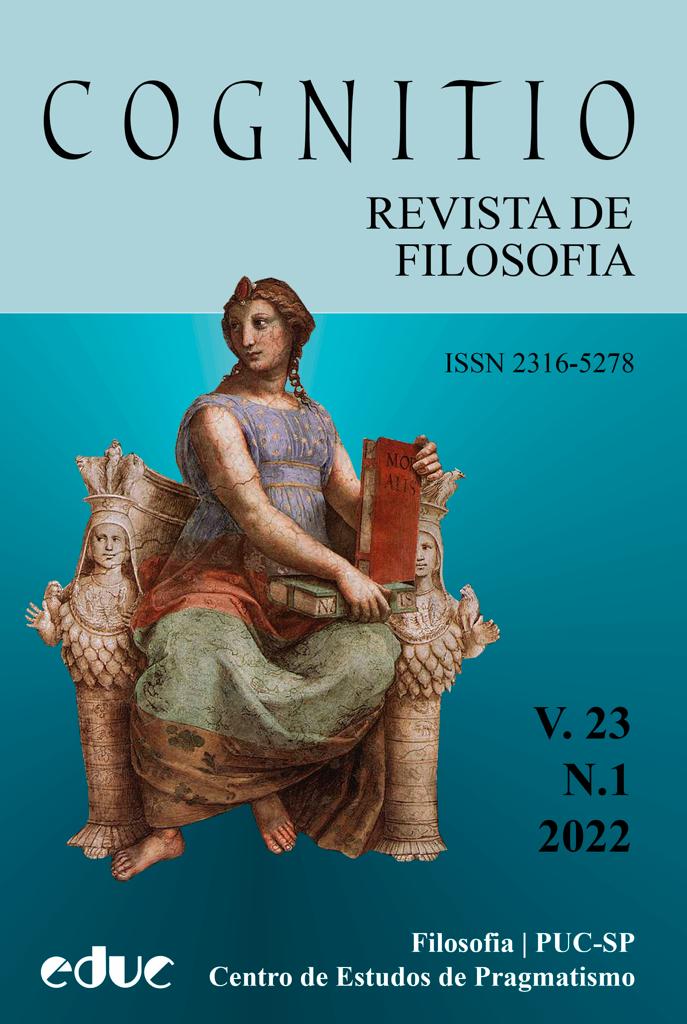Indeterminação e causação final no processo de determinação sígnica
DOI:
https://doi.org/10.23925/2316-5278.2022v23i1:e59925Resumo
Em semiótica, causação final pode estar relacionada aos processos de determinação (PAPE, 1993). Do ponto de vista de Peirce, a determinação não é um determinismo causal, mas uma delimitação de uma gama de possibilidades. Aquela que começa dos objetos para os interpretantes, em um processo mediado pelo signo, no qual o objeto dinâmico funciona como uma força que limita os interpretantes para corresponder aos seus objetos. A correspondência entre o objeto e o interpretante é importante pois é através de um interpretante gerado que o objeto de um signo pode ser conhecido. Mesmo que esse processo de determinação coincida com a ideia de causação final, há uma certa indeterminação nela. Para Peirce (EP 2:353, 1905), vagueza e generalidade são dois tipos de indeterminação. Nos termos das categorias fenomenológicas, vagueza é uma indeterminação da ordem de primeiridade, generalidade uma indeterminação da ordem da terceiridade e, ambas, em alguma medida, são opostas a aquilo que é definido, que pertence à segundidade. Cada aspecto do signo pode variar segundo as três categorias fenomenológicas. Consequentemente, graus de imprecisão são adicionados ao processo semiótico, que é um processo de determinação. Peirce afirma que a precisão perfeita do pensamento é teoreticamente inatingível (SS 11, 1903). Todo signo é vago ou geral pelo menos em algum grau. Neste artigo, buscamos entender os graus de indeterminação e causalidade a partir de uma análise dos tipos de objetos e de interpretantes propostos por Peirce no sistema de 28 classes de signos.Referências
BORGES, Priscila. Mensagens cifradas: a criação de linguagens diagramáticas. Tese (Doutorado em Comunicação e Semiótica) – Programa de Comunicação e Semiótica, Pontifícia Universidade Católica de São Paulo, São Paulo, 2010.
BORGES, Priscila. Peirce’s System of 66 Classes of Signs. In: THELLEFSEN, Torkild; SØRENSEN, Bent (Org.). Charles Sanders Peirce in his own words. Boston; Berlin: De Gruyter Mouton, 2014. p. 571-576. DOI: https://doi.org/10.1515/9781614516415.507
BORGES, Priscila. A System of 21 Classes of Signs as an Instrument of Inquiry. The American Journal of Semiotics, v. 31, n. 3-4, p. 245-276, 2015. DOI: https://doi.org/10.5840/ajs2016153
BORGES, Priscila; FRANCO, Juliana R. Causalidade, classes naturais e Interpretantes Finais. Uma abordagem semiótica para a causação final. In: ARAÚJO, Arthur (Org.). Pragmatismo, semiótica, filosofia da mente e filosofia da neurociência. São Paulo: ANPOF, 2019. p. 85-93.
CARUS, Paul. Mr. Charles S. Peirce’s Onslaught on the Doctrine of Necessity. The Monist, v. 2, n. 4, p. 560-582, 1892. DOI: https://doi.org/10.5840/monist18922428
CARUS, Paul. The Founder of Tychism, His Methods, Philosophy, and Criticisms: In Reply to Mr. Charles S. Peirce. The Monist, v. 3, n. 4, p. 571-622, 1893. DOI: https://doi.org/10.5840/monist18933420
FARIAS, Priscila; QUEIROZ, João. On Diagrams for Peirce’s 10, 28, and 66 Classes of Signs, Semiotica, v. 147, p. 165-184, 2003. DOI: https://doi.org/10.1515/semi.2003.089
FRANCO, Juliana Rocha; BORGES, Priscila M. O real na filosofia de Charles S. Peirce. Teccogs: Revista Digital de Tecnologias Cognitivas, TIDD | PUC-SP, São Paulo, n. 12, p. 66-91, jul-dez. 2015.
FRANCO, Juliana Rocha; BORGES, Priscila M. Potencialidades Heurísticas dos Diagramas Dedutivos: uma abordagem peirceana. In: ARAÚJO, Arthur; CORREIA, Adriano; GHIRALDELLI, Paulo; MOGRABI, Gabriel. (Org.). Pragmatismo, Filosofia da Mente e Neurociência. v. 1. 1ed. São Paulo: Anpof, 2017. p. 59-77.
FRANCO, Juliana Rocha; BORGES, Priscila M. Diagrammatic relations of probative strength and inferential progression through semiotics. Semiotica, v. 228, p. 77-89, 2019. DOI: https://doi.org/10.1515/sem-2018-0088
HULSWIT, M. A short history of causation. S.E.E.D. Journal (Semiotics, Evolution, Energy, and Development), v. 4, n. 3, p. 16-42, 2004.
FRANCO, Juliana Rocha; BORGES, Priscila M. From cause to causation: A Peircean perspective (Vol. 90). Springer Science & Business Media, 2002.
FRANCO, Juliana Rocha; BORGES, Priscila M. Peirce’s teleological approach to natural classes. Transactions of the Charles S. Peirce Society, 33(3), p.722-772, 1997.
JAMES, William. The will to believe and Other Essays in Popular Philosophy. London: Longmans, Green, and Co., 1896.
MÜLLER, Ralf. On the Principles of Construction and the Order of Peirce’s Trichotomies of Signs. Transactions of the Charles S. Peirce Society, v. 30, n. 1, p. 135-153, 1994.
PAPE, Helmut. Final Causality in Peirce’s Semiotics and his Classification of the Sciences. Transactions of the Charles S. Peirce Society, v. 29, n. 4, p. 581-607, 1993.
PEIRCE, Charles S. The doctrine of necessity examined. The Monist, v. 2, n. 3, p. 321-337, 1892. DOI: https://doi.org/10.5840/monist18922321
PEIRCE, Charles S. Reply to the necessitarians: Rejoinder to Dr. Carus. The Monist, v. 3, n. 4, p. 526-570, 1893. DOI: https://doi.org/10.5840/monist18933412
PEIRCE, Charles S. Necessity. In: BALDWIN, J. M. (Ed.), Dictionary of Philosophy and Psychology, vol. II. London: Macmillan and Co, 1902a. p. 143-146.
PEIRCE, Charles S. Vague. In: BALDWIN, J. M. (Ed.), Dictionary of Philosophy and Psychology, vol. II. London: Macmillan and Co, 1902b. p. 143-146.
PEIRCE, Charles S. What Pragmatism Is. The Monist, v. 15, n. 2, p. 161-181, 1905a. DOI: https://doi.org/10.5840/monist190515230
PEIRCE, Charles S. The issues of pragmaticism. The Monist, v. 15, n. 4, p. 481-499, 1905b. DOI: https://doi.org/10.5840/monist19051544
PEIRCE, Charles S. Prolegomena to an Apology of Pragmaticism. The Monist, v. 16, n. 4, p. 492-546, October 1906. DOI: https://doi.org/10.5840/monist190616436
PEIRCE, Charles S. Collected papers of Charles Sanders Peirce. HARTSHORNE, Charles. WEISS, Paul (Eds.). v. 1-6. BURKS, Arthur W (Ed.). v. 7-8. Cambridge, MA: Harvard University Press, 1931-1935; and 1958. 8 v.
PEIRCE, Charles S. The essential Peirce: selected philosophical writings. HOUSER, Nathan; KLOESEL, Christian; Peirce Edition Project (Eds.). Bloomington, IN: Indiana University Press, 1992; 1998. 2 v.
PEIRCE, Charles S. New elements of mathematics. EISELE, C. (Ed.), The Hague: Mouton Press, 1976. 5 v.
PEIRCE, Charles S. Logic Notebook (1865-1909). In: PEIRCE, Charles S. The Charles S. Peirce Papers, Microfilm Edition, thirty reels with two supplementary reels later added. Cambridge, MA: Harvard University Library Photographic Service, 1966.
PEIRCE, Charles S.; WELBY, Victoria. Semiotic and significs: the correspondence between Charles S. Peirce and Lady Victoria Welby. HARDWICK, Charles S. (ed.). Bloomington; Indianapolis: Indiana University Press, 1977.
RANSDELL, Joseph. Some leading ideas of Peirce’s semiotic. Semiotica. v. 19, n. 3-4, p. 157-178, 1977. DOI: https://doi.org/10.1515/semi.1977.19.3-4.157
SANTAELLA, Lucia. Os significados pragmáticos da mente e o sinequismo em Peirce. Cognitio: Revista de Filosofia, n. 3, p. 97-106, 2002.
SANDERS, Gary. Peirce’s Sixty-six Signs?. Transactions of the Charles S. Peirce Society, v. 6, n. 1. p. 3-16, 1970.
WEISS, Paul; BURKS, Arthur. Peirce’s Sixty-six Signs. Journal of Philosophy, v. 42, n. 14, p. 383-388, 1945. DOI: https://doi.org/10.2307/2019195
Downloads
Publicado
Como Citar
Edição
Seção
Licença
Copyright (c) 2022 http://creativecommons.org/licenses/by/4.0/

Este trabalho está licenciado sob uma licença Creative Commons Attribution 4.0 International License.









